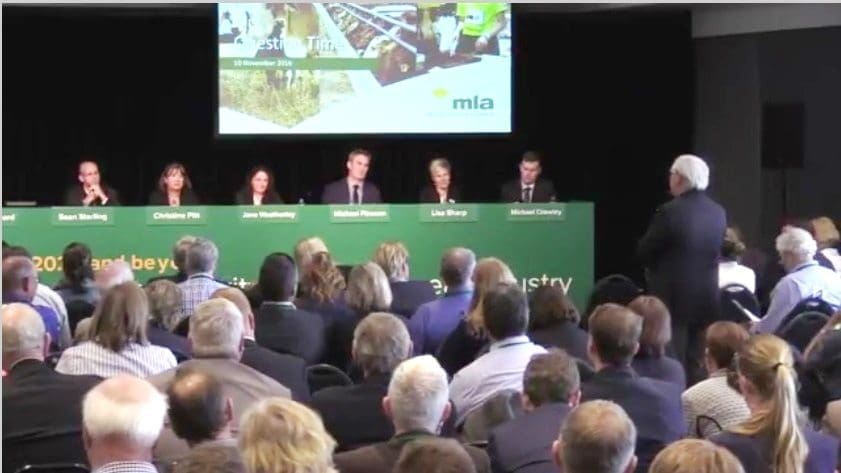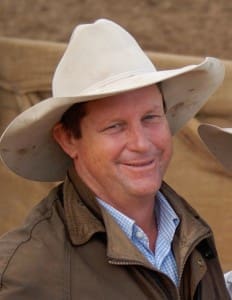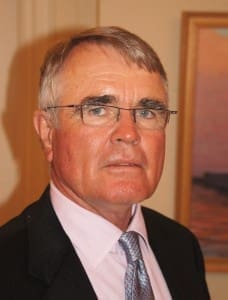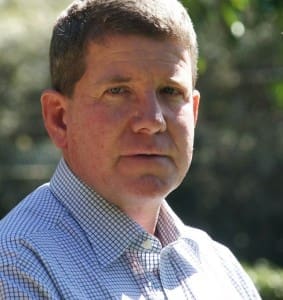
Queensland lotfeeder Kev Roberts from Sandalwood feedlot poses a question during yesterday’s industry forums near Adelaide
LONG-DISTANCE transport issues, relocating processing operations to regional areas, future directions for the MSA program, and MLA’s responses to recent TV coverage about beef production – these were some of the topics on producers’ minds during question-time in forums held as part of MLA’s AGM process near Adelaide yesterday.
Here’s a sample of some of the dialogue around topics raised at yesterday’s forums:
Collaborative marketing projects:
Q: A Bairnsdale, VIC producer asked why MLA was subsidising ‘non retail’ entities like AA Co, Teys and JBS to the tune of $200,000 for collaborative marketing projects, when they were big enough to ‘stand on their own feet’.
A: MLA’s Lisa Sharp said the Collaborative Marketing program matched individual company contributions with levy dollars for marketing purposes. “It is a very tight eligibility criteria, and the companies that you name all have branded products that appear in domestic and export markets. Through the program, we are seeking to remove some of the risk of entry into those markets, and building those brands in particular markets. All those brands have a strong foundation in ‘brand Australia’, and we certainly believe there are ‘halo’ benefits for broader Australian product, on the back of those collaborative investments.”
Updating MSA sensory testing:

Blair Angus
Q: Blair Angus from Central Queensland said much of the MSA sensory testing work was now quite dated (conducted in the 1990s-2000s), and he asked whether MSA had plans to update it, and perhaps determine where the real genetic gain is.
A: “Absolutely,” MSA general manager Michael Crowley said. “When we’re talking about aligning the key commercial drivers, it’s about putting the consumer first. When we’re looking at what’s going to drive future genetic gain, it’s about delivering better outcomes for consumers – that’s the only point where money is entering the supply chain. What are those commercial drivers that increase value? It’s in improving market compliance specifications. Every one percent increase in market compliance is worth an additional $16 million return to the industry. That’s where we need to get that genetic investment aligning with our consumer outcomes.”
Future direction for MSA:
Q: Where does MSA go next, an online forum viewer asked.
A: “Beef and sheepmeat MSA taskforces have developed a five-year plan, which has set some key priorities for the program,” Michael Crowley said. “By 2020, we want to ensure that all cattle and sheep are eligible for MSA grading – identifying the blockers in the pathways to at least create the opportunity for all livestock to be MSA graded. We want to make sure that more cuts per carcase are being packed as MSA, which is about enabling a fitness for purpose for all cuts to match a consumer outcome. That ultimately is going to add a lot of value to the supply chain. One of the key changes is that we’re looking to brand owners to drive the success of MSA. We’re looking to support brand owners to drive that point of difference and add value to those brands that use the system, which ultimately delivers better returns through the supply chain. And we need to work with producers to get a better understanding of the program.
Tackling challenge of transport distance:

Peter Hughes
Q: North Queensland beef producer Peter Hughes said while MLA was doing some ‘wonderful work,’ what was often forgotten was that a lot of Australia was a long, long way from anywhere. There were parts of the north where a beast on a truck had a 3000km journey before it reached the first processing plant. Even the productive Barkly region was 1400km to the nearest abattoir. “It’s like running a marathon before the beast is slaughtered, which is counter-productive to eating quality, as well as having welfare implications. The transport industry came a long way about 30 years ago, but has now hit the wall, and I think there are ways that we can improve those trucks, or start processing out in those areas. On one of our places, at one stage cattle were six hours on a truck before they reached the boundary fence. We need to be careful in R&D that we do not get in front of ourselves, with where we apply the focus. There’s a lot of cattle being carted a long way in Australia, and it’s very expensive – I’m sure we can go back and do some more work on transport, to get our priorities into perspective.”
A: Michael Crowley said MSA work on long distance transport found the current ‘window’ was 36 hours, including 12 hours in lairage. “Outside of those boundaries, we may need to look at other commercial outcomes – whether we can get livestock closer to a plant for some recovery time, and how we manage those cattle to get muscle glycogen levels back up to where they were at the time the cattle were loaded. If they do fall out of that window, what is the impact for the consumer? We need to measure and monitor that. There’s going to be some good learnings from that work.”
Q: Queensland lotfeeder Kev Roberts said trials at Sandalwood feedlot, on cattle moved long distance from the state’s far western channel country, had found that it took 21 days for such cattle going on feed in a feedlot to full re-hydrate. “It works particularly well, because we know that by the time an animal is transported 1500km or more, shrink (bodyweight loss) can be in the order of 15-20pc. By the time that animal is re-hydrated and shipped a small distance to the meatworks, it’s shrunk is often only less than 5pc. The answer is there.”
Location of processing assets:

CQ cattle producer Ian McCamley
Q: In what was more of a statement than a question, Central Queensland cattleman Ian McCamley called for decentralisation of beef processing. “In many businesses, get the logistics right, and it will underpin what you do. Here we are, lugging cattle miles and miles to get to a meatworks. Livestock transport is the most inefficient transport system in the country, it operates 52pc loaded, 48pc empty. It’s just dumb. It costs five times as much to transport a live animal as it does to transport boxed beef of the same weight in a fridge van. Yet these meatworks, by and large, are located along the coastal fringe, often in suburbs of cities. Trucks in transit stop at 27 sets of traffic lights, and we wonder why we’re getting dark cutters. You pull up at McDonald’s at Beenleigh for a burger on the way to the Gold Coast and all you can smell is the meatworks. It’s incredible that they are still there, given that the land is worth a fortune. We need to be working with governments to try to move these plants out into regional areas – all these areas have grown, and can sustain a meatworks with labour. Let’s catch up with our processing, build some brand new plants off the coast, and start saving some money, and a few lives as well.”
MLA’s responses to recent television coverage about beef production

Mick Hewitt
Q: Queensland beef producer Mick Hewitt focussed attention on a recent SBS television series called For the Love of Meat, featuring Matthew Evans. “Was MLA aware of the program, and what is its planned response? he asked. What I find concerning as a beef producer is that I’m constantly stopped by colleagues in Brisbane who know I’m in the beef industry, asking about the SBS series. Are we going to continue to be reactive, or proactive to such programs?
A: With respect to SBS’s “For the Love of Meat” program, MLA was ‘absolutely aware’ of its production, MLA’s Lisa Sharp said. “We were contacted 11 months ago, when SBS was starting to research the process,” she said. “What we wanted to do was be constructive, and make sure that fact-based information was made available to the program’s producers. Indeed MLA, on behalf of industry, coordinated a number of interviews with members across the production spectrum, through to retail.
“We worked closely with the peak industry councils, in the event of any adverse media reaction from the program. The report aired last Thursday, and we watched very carefully the consumer reactions to the program via Media Monitors, and social media. Not-so-good things about meat are unfortunately not new, but in our opinion there was not a lot of new news in that program. There were a few inaccuracies, and elements that were not ideal, but with the absolute lack of social media and mass media pick-up afterwards, it meant that we do not want to throw fuel on the fire,” Ms Sharp said.
“The reality is that there is a very small number of consumers who are outraged about the practises used in the red meat industry – as indeed they are with many other industries. There’s a small group of consumers who are concerned, but the vast majority are curious, or just not interested – it’s not on their radar.
“Our job is to look carefully at how many are outraged or concerned, and always have compelling, fact-based information available about the very good practises in the red meat industry, and to work with the peak industry councils and other influencers.
“If I’d gone on TV on Friday morning after the program as Lisa Sharp from MLA, claiming the program contained gross inaccuracies, it’s not credible. What is a lot more credible is when other influencers speak about our industry – especially producers speaking about good industry practise – that’s far more credible.”
“But in addition to always being ready for those type of issues – whether it be in nutrition and health, stewardship of our natural resource base, or animal welfare – we are always building evidence, and ensuring that information is in the hands of influencers and policy-makers.”
Kev Roberts from Sandalwood feedlot told the forum audience he had been part of the SBS program. “I watched all three segments. They belted the chicken and pig industries mercilessly, but I think beef came out of it very, very well,” Mr Roberts said. “Beef did not get bashed up, and I can confirm that MLA was well prepared. We made sure during their visit to Sandalwood that they had all the facts. They wanted to look at HGPs in cattle, and we talked them out of it, as an issue, based on the facts.”
“I think MLA and the industry got it right, in its approach.”
Lost opportunity?
An earlier Red Meat Advisory Council forum involving the seven peak council groups absorbed so much time with delivery of “who we are, and what we do,” content that only a token allowance of time was left at the end for the meeting’s primary purpose: engagement with grassroots stakeholders.
To leave just six or seven minutes for questions at the end of a 90 minute forum like this, with many stakeholders travelling thousands of kilometres to attend, was a poor outcome. The word ‘forum’ clearly suggests two-way communication, and there was very little of it in this RMAC session yesterday morning.
In Beef Central’s opinion, next year such peak council information should be provided in compendium form, in each delegate’s satchel. Give each peak council just five minutes to highlight the big-ticket, front-of-mind issues currently impacting on their sector, and leave the remaining hour to get stuck into the primary ‘forum’ objective of fielding and responding to questions from levy payers.

I can’t believe that MLA is holding the beef industry back as much as it is. It is totally obvious that live animals shouldn’t have to travel 3000klm. To put this in perspective this is from Barcelona to Moscow. Sure there are high mountains but there are also tunnels and often great highways. Our cattle just get hot, dehydrated (in spite of the stops) and very tired. Obviously the meat quality crashes. This has long suited the feed lotters who position themselves as cattle recovery resorts and their influence has overwhelmed the technocrats at MLA. Cattle Council Australia forgot their constituency years ago when I was taking them on. I was told grass is just backgrounding for feedlots. The whole Australian beef industry forgot who it was and what its product was which was grass fed meat. But now the world wants free range and we can do it if we bring back regional processors. ALL THIS TALK ABOUT REGIONAL DEVELOPMENT. TIME TO DO IT! Abattoirs employ a lot onsite and behind the scenes. Country towns need them. If I were a beef producer I would be very angry
I do apologise to the Teys Australia management and staff at Beenleigh for my comment regarding smell. I do acknowledge all the very successful work they have done in this area.
To the editor,
Thank you.
Val Cormack
Ian McCamley’s comment is 110% correct. Since October 2013 some people will have seen my footprints, where I have been pushing for Beef Abattoirs to be built at Charters Towers, Emerald and Roma where the cattle are breed. I have now purchased 500 acres of Industrial land at Pickanjinnie, between Wallumbilla and Roma and in the process of putting in a development application to build a 1200 head a day beef Abattoirs. I have a Chinese born business partner, who is married to a Australian and have 2 children and live in Brisbane. When we reach a certain stage of the project, we will be contacting beef producers in the Roma cattle catchment area asking what you require regarding changes to the present grading system. I have heard the reason the Processing factory’s were built on the coast, was the problem with keeping the meat cold, with todays teck this can be worked thru, with Abattoirs at Hughenden, Emerald and Roma.
There is a lot to discuss regarding new Abattoirs, What is good for the cattle, is good for not only beef producers but the whole Australian beef industry, we need to keep our reputation as no 1 in the world at the front of any changes to our industry.
Val Cormack.
Just out of interest, Val, here’s a brief list off the top of our heads of defunct meatworks that once existed in ‘inland’ parts of Queensland/NT away from the major metropolitan centres: Tancreds Pentland; Tancreds Mt Isa; Cloncurry; Morex (earlier, AW Anderson) Roma; Mareeba; Katherine; Tennant Creek. Question to ponder: Is there a common reason why attrition has been so much higher off the coast? Editor.